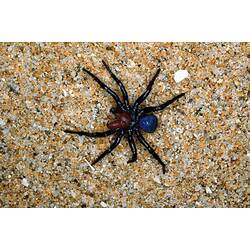General Description
Smooth, glossy carapace; head area is high, steep and broad with very large, bulbous jaws. Eyes are widespread across the front of their head. The spinnerets, at the back of the abdomen, are short and blunt. Females are uniformly dark brown to black and larger than males. Males have a bright red head and jaws and gunmetal blue to black abdomens. Body size up to 3.5 cm.
Biology
Red Headed Mouse Spiders live in burrows in the ground, often in banks of rivers, creeks and other waterways, and is sometimes found in suburban gardens. Males are usually found wandering for females during the day in late summer to early winter. They tend to be more common especially after rain. Females remain in their burrows. Females lay 60 or more eggs within an egg sac that she places into a brood chamber off the main shaft of her burrow. The spiderlings hatch over summer and remain with the mother into autumn when dispersal occurs. The spiderlings disperse by ballooning, a technique that is rare in mygalomorphs and possibly explains the relatively wide distribution of this species compared to other mygalomorph species. They mainly prey on insects and other spiders, but also occasionally on small vertebrates, such as frogs and lizards.
Distribution
Central Australia.
Habitat
Open forest to semi-arid shrubland.
More Information
-
Animal Type
-
Animal SubType
-
Brief Id
Smooth, glossy carapace; head area is high, steep and broad with very large, bulbous jaws.
-
Colours
Red, Blue, Black
-
Maximum Size
3.5 cm
-
Habitats
-
Diet
Carnivore
-
Hazards
Venom may be very toxic, but few cases of serious envenomation have been recorded.
-
Endemicity
-
Commercial
No
-
Conservation Statuses
CITES: Not listed, FFG Threatened List: Not listed, EPBC Act 1999: Not listed, IUCN Red List: Not listed
-
Taxon Name
-
Scientific Author
Walckenaer, 1805
-
Common Name
Red Headed Mouse Spider
-
Kingdom
-
Phylum
-
Subphylum
-
Class
-
Order
-
Infraorder
-
Family
-
Genus
-
Species Name
occatoria




